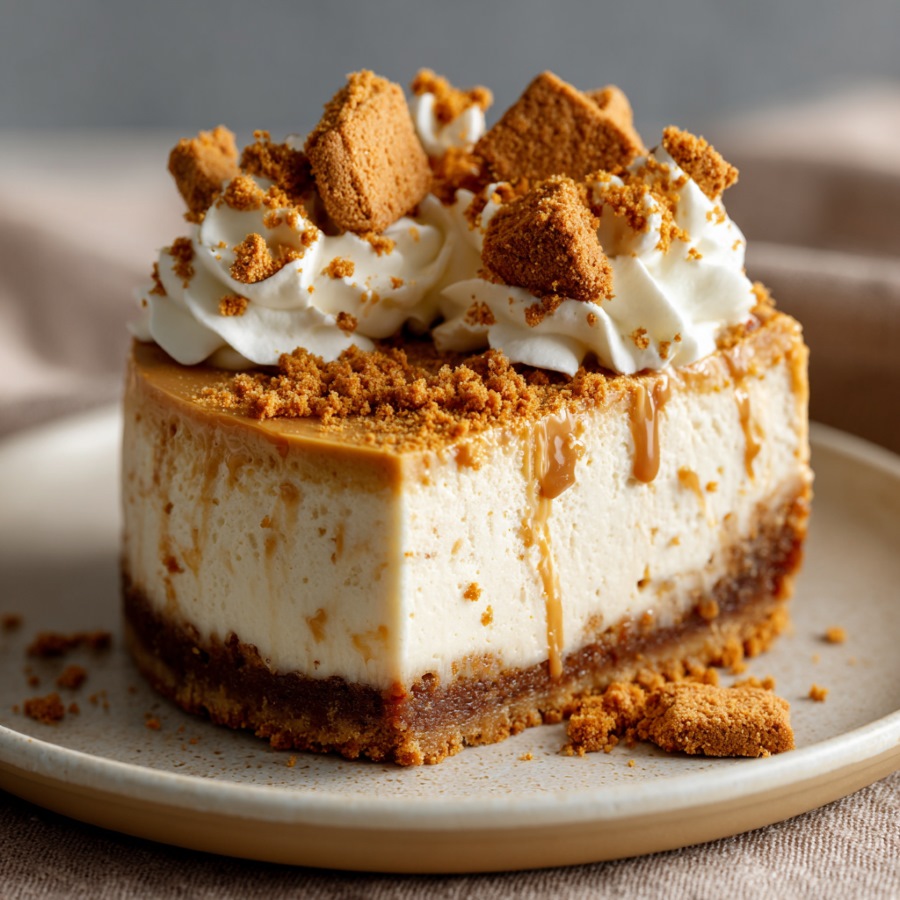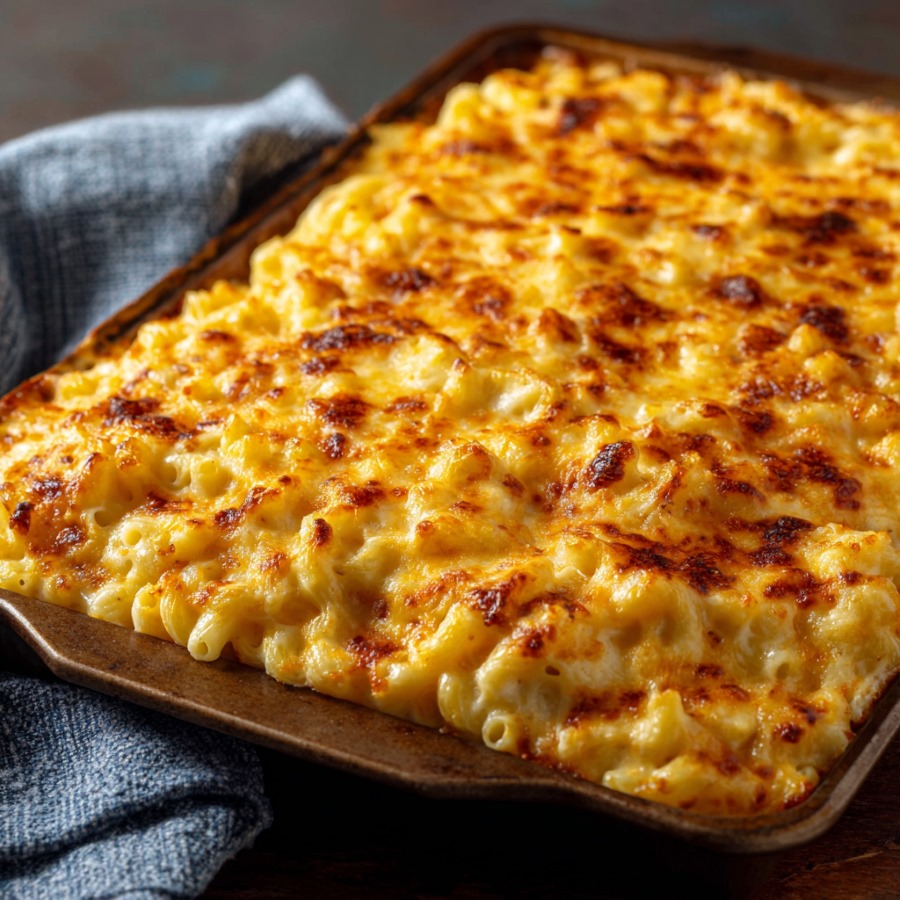Last spring, I volunteered to help organize dessert trays for a community fundraiser at the old railway museum downtown. A charming place with creaky floors and shelves of antique teapots, it reminded me of the kind of history I once taught in classrooms. My task was to bring something unique for the dessert table, something comforting but a little unexpected.
One of the younger volunteers, a bright-eyed intern studying culinary arts, brought along a jar of Biscoff spread and raved about how his host family in Belgium used it in everything from toast to truffles. That sparked an idea.
Later that evening, after a long walk back home, I set to work with what I had. I knew I wanted something creamy and rich with a crust that held up—something bold but familiar. Cheesecake has always been my go-to dessert for special occasions, but this time, instead of the usual graham crackers, I crushed those cinnamony Biscoff cookies into a golden, buttery base. A swirl of Biscoff spread into the filling brought the whole thing together. It had a soft elegance to it—sweet, lightly spiced, and perfect with coffee or tea.
The next day, as people wandered the exhibit with plates in hand, I saw more than one person sneak back for a second slice. The intern came over, eyes wide, and said, “You really baked this?” I smiled, nodded, and handed him the recipe scribbled on a napkin. That cheesecake ended up being the most requested dessert of the event.

Short Description
A smooth, creamy cheesecake infused with Biscoff spread and set over a spiced cookie crust. Finished with whipped cream and crushed cookies, it’s a showstopper for any occasion.
Key Ingredients
For the Crust:
- 24 Biscoff cookies (approx. 7 oz)
- 7 tablespoons unsalted butter, melted
- 2 tablespoons granulated sugar (optional)
For the Cheesecake Filling:
- 18 ounces cream cheese, softened
- 3/4 cup granulated sugar
- 3/4 cup sour cream
- 1 teaspoon vanilla extract
- 3 large eggs, room temperature
- 1/2 cup Biscoff spread
For Finishing:
- Whipped cream (for garnish)
- Crushed Biscoff cookies (for sprinkling)
Tools Needed
- Food processor or rolling pin (to crush cookies)
- 9-inch springform pan
- Mixing bowls
- Hand or stand mixer
- Spatula
- Oven
- Cooling rack
Cooking Instructions
Step 1: Prepare the Crust
Preheat your oven to 350°F (180°C). Crush the Biscoff cookies in a food processor until fine. Combine with melted butter and sugar, mixing until evenly coated. Press the mixture firmly into the base of a 9-inch springform pan. Bake for 10 minutes, then set aside to cool completely.
Step 2: Make the Cheesecake Filling
In a large mixing bowl, beat softened cream cheese until smooth and creamy. Add the sugar, sour cream, and vanilla, blending until fully combined. One at a time, add the eggs, mixing gently after each. Finally, fold in the Biscoff spread until well incorporated.
Step 3: Fill and Bake
Pour the cheesecake filling over the cooled crust. Smooth the top with a spatula. Bake in the preheated oven for 50 to 60 minutes. The edges should look set while the center should slightly jiggle when moved.
Step 4: Cool Gradually
Turn off the oven and crack the door slightly. Leave the cheesecake inside for 1 hour to cool slowly and prevent cracking.
Step 5: Chill Overnight
Transfer the cheesecake to the refrigerator and let it chill for at least 4 hours, or preferably overnight, until fully set.
Step 6: Garnish and Serve
Before serving, pipe or spoon whipped cream on top and sprinkle with crushed Biscoff cookies for a bit of crunch and charm.
Why You’ll Love This Recipe
Creamy and Rich: Every bite is velvety smooth with just enough Biscoff flavor to make it stand out.
Unique Flavor: The spiced cookie crust and cookie butter swirl give it a warm, caramel-like sweetness.
Easy to Make Ahead: Perfect for preparing the night before a party or gathering.
Crowd Pleaser: Elegant enough for holidays, easy enough for weekends.
Customizable: Dress it up or down with toppings, sauces, or even a chocolate drizzle.
Mistakes to Avoid & Solutions
Overbaking the Cheesecake
Problem: The top cracks or dries out.
Solution: Stop baking once the edges are firm but the center jiggles slightly. Don’t worry—it will continue to set as it cools.
Skipping the Water Bath
Problem: Uneven texture or cracking.
Solution: While not required, placing a shallow pan of water on the rack below helps regulate oven moisture.
Using Cold Ingredients
Problem: Lumpy batter.
Solution: Let cream cheese, eggs, and sour cream come to room temperature before mixing.
Rushing the Cooling Process
Problem: Surface cracks and sunken centers.
Solution: Always cool in the oven first with the door ajar before refrigerating.
Serving and Pairing Suggestions
Serve chilled, garnished with whipped cream and cookie crumbles.
Great as a centerpiece dessert for holidays, brunches, or potlucks.
Pair with a cup of espresso, a glass of dessert wine, or a chai latte.
Also lovely with berries or a thin drizzle of caramel sauce.
For dinner parties, slice in advance and plate individually with a small mint leaf.
Storage and Reheating Tips
Refrigerate: Cover the cheesecake and refrigerate for up to 5 days.
Freeze: Wrap individual slices tightly and freeze for up to 2 months. Thaw overnight in the fridge before serving.
Avoid microwaving: To preserve the texture, don’t reheat. Cheesecake is best served chilled or at room temperature.
FAQs
1. How do I know when the cheesecake is done baking?
Look for edges that are set and a center that jiggles slightly—like gelatin—not liquid.
2. Can I make this cheesecake without a springform pan?
Yes, but a springform pan makes it easier to remove the cake without damage. If using a regular pan, line it with parchment for easier lifting.
3. What’s the best way to crush Biscoff cookies without a food processor?
Place the cookies in a zip-top bag and crush them with a rolling pin or heavy-bottomed pan.
4. Can I use low-fat cream cheese?
You can, but it may result in a softer texture. Full-fat cream cheese yields the creamiest results.
5. My cheesecake cracked. Can I fix it?
You can cover cracks with whipped cream or crushed cookies. Cooling slowly and not overbaking helps prevent cracks.
Tips & Tricks
Gently tap the pan on the counter before baking to release air bubbles.
Use a hot knife (wiped clean between slices) for neat serving.
For a firmer crust, press it up slightly along the sides of the pan.
Want a deeper Biscoff flavor? Swirl an extra tablespoon of spread into the batter before baking.
Don’t overmix the batter once eggs are added, it can incorporate too much air.
Recipe Variations
Chocolate Biscoff Cheesecake
Swap 1/4 cup of Biscoff spread with melted dark chocolate.
Add 2 tablespoons cocoa powder to the crust.
Flavor profile: Rich, bittersweet with a spicy undertone.
No-Bake Version
Omit eggs. Use 1 cup whipped cream folded into the cream cheese filling.
Refrigerate for 6 hours instead of baking.
Lighter, mousse-like texture.
Mini Biscoff Cheesecakes
Use a muffin tin with liners. Press 1 tablespoon crust into each.
Bake crusts for 5 minutes, then fill and bake 20–22 minutes.
Great for parties or portion control.
Final Thoughts
Last week, while visiting my niece’s new apartment, she shyly asked if I could help her “bake something impressive” for her first dinner party. I brought along a springform pan, a few ingredients, and this recipe. As we folded the creamy filling and pressed the golden crust, I realized these little moments in the kitchen—sharing stories, passing down techniques—are my favorite part of baking.
Watching her proudly serve that cheesecake, then beam as her friends reached for second slices, reminded me why I keep cooking, teaching, and writing these recipes. It’s not just about dessert. It’s about connection, tradition, and joy—one slice at a time.

Ingredients
- For the Crust:
- 24 Biscoff cookies (approx. 7 oz)
- 7 tablespoons unsalted butter, melted
- 2 tablespoons granulated sugar (optional)
- For the Cheesecake Filling:
- 18 ounces cream cheese, softened
- 3/4 cup granulated sugar
- 3/4 cup sour cream
- 1 teaspoon vanilla extract
- 3 large eggs, room temperature
- 1/2 cup Biscoff spread
- For Finishing:
- Whipped cream (for garnish)
- Crushed Biscoff cookies (for sprinkling)
Instructions
Step 1: Prep the Crust
Preheat oven to 350°F (180°C). Crush Biscoff cookies, mix with melted butter and sugar, then press into a 9-inch springform pan. Bake for 10 minutes; let cool.
Step 2: Make Filling
Beat cream cheese until smooth. Add sugar, sour cream, and vanilla; mix well. Add eggs one at a time, then fold in Biscoff spread.
Step 3: Fill & Bake
Pour filling over crust. Smooth top and bake for 50–60 minutes until edges are set and center slightly jiggles.
Step 4: Cool Gradually
Turn off oven, crack door, and let cheesecake rest inside for 1 hour.
Step 5: Chill
Refrigerate for at least 4 hours or overnight until fully set.
Step 6: Garnish
Top with whipped cream and crushed Biscoff cookies before serving.


